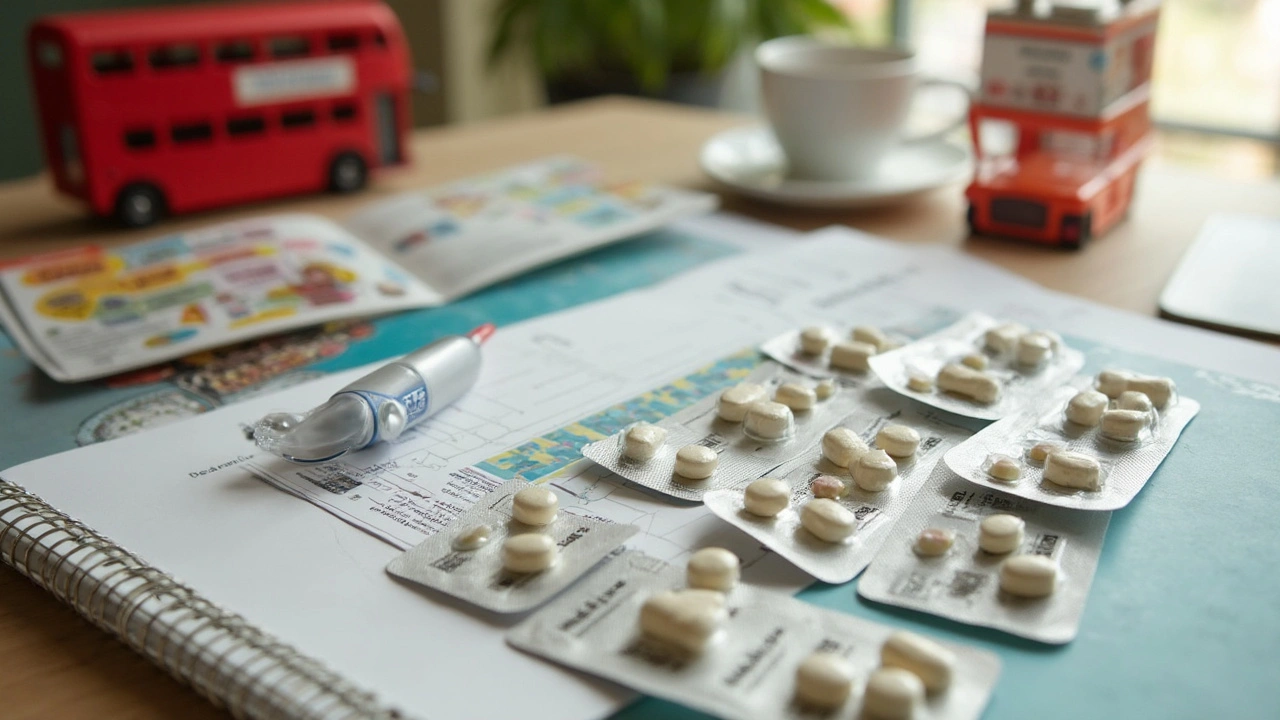Ever felt lost looking at a list of antibiotics with wildly similar names? Your doctor suggests amoxicillin, but your neighbor swears by penicillin V. Maybe someone whispers about new super-bugs and the best ways to stay protected. Here’s the thing: not all penicillins are created equal, and picking the right one can affect how well you recover from an infection, whether you experience any not-so-fun side effects, or even how your body handles future bugs.
What Sets Amoxicillin Apart from Other Penicillins?
It’s wild to think that one moldy petri dish back in 1928 kicked off the whole penicillin family. Since then, researchers have tinkered with natural penicillin, branching it into a giant clan. Amoxicillin shot to fame in the 1970s, winning fans for being easy on the stomach and handy for tough ear, sinus, and lung infections, including some stubborn bacterial strains that regular penicillin just couldn’t crush. Today, it’s everywhere—your dentist’s cabinet, urgent care, even some hospital IV bags.
But what actually makes amoxicillin different from classic penicillin or its cousins like ampicillin and dicloxacillin? Let’s break down what’s under the hood:
- Amoxicillin: Deliciously easy to swallow (that bubblegum taste? Iconic), hangs out in your blood longer, and gets inside tissues faster than plain penicillin. Doctors like it for middle-ear, throat, and lower respiratory infections, especially in kids who can’t keep food down. It isn’t as easily zapped by stomach acid, so it’s a favorite in tablet, capsule, or syrup form. It also does double duty with other meds for H. pylori in the stomach.
- Penicillin V: The classic. It’s the stalwart workhorse, still awesome for strep throat and dental infections, but broken down quickly by stomach acid (which can make dosing trickier).
- Ampicillin: Similar-but-different to amoxicillin, but it’s less absorbed in your gut and can cause more stomach drama. Docs sometimes use it in hospitals, usually for meningitis or serious pneumonia.
- Dicloxacillin and Cloxacillin: Designed for fighting specific "bad bugs" like penicillinase-producing staph (think of them as tough reinforcers against bacteria that have learned new tricks).
If you want to see a side-by-side breakdown, check this out:
| Antibiotic | Usual Uses | Oral Absorption | Common Side Effects | Notes |
|---|---|---|---|---|
| Amoxicillin | Ear, sinus, throat, lower lungs, dental, H. pylori | High | Diarrhea, nausea, skin rash | More acid-resistant; often 2-3x daily |
| Penicillin V | Strep throat, dental, rheumatic fever | Variable (lower than amox) | Rash, stomach upset | Frequent dosing needed |
| Ampicillin | Serious infections (IV), some oral | Lower | Diarrhea, allergic reactions | Used more in hospital settings |
| Dicloxacillin | Staph skin infections | Good | Nausea, joint pain | Good for resistant staph (MSSA) |
Here’s something people rarely mention: no matter which penicillin you’re on, allergic reactions are still the wild card. Some folks break out in hives after one dose; others get stomach aches that just won’t quit. Because all penicillins are related, being allergic to one often knocks out the whole family (though there are a few exceptions—chat with your doc if you’re not sure).
Amoxicillin is especially popular in pediatric settings—it doesn’t make kids as queasy, and sweet flavors go down easier than chalky pills. In Seattle, I swear every other parent’s backpack has a tiny bottle of it, just in case. My vet even mentioned it as a safe pick for dogs (though Declan’s never needed it—knock on wood!).

How to Know If You Need Amoxicillin or Another Penicillin
If you’ve ever had a prescription and wondered, “Why this one?” you’re not alone. Doctors weigh a bunch of factors before picking amoxicillin or another penicillin. Here’s how it usually shakes out:
- Type of infection: Ear infections, strep throat, and sinus infections? Amoxicillin is usually king. Skin infections caused by staph? Dicloxacillin might be your ticket. For dental infections, penicillin V is still a classic pick.
- Bacteria involved: Some bugs laugh off regular penicillin but are still vulnerable to amoxicillin. Doctors may send off a “culture” to match the right antibiotic to the germ. If you’re dealing with resistant bacteria, they may skip straight to a combo pill—think amoxicillin plus clavulanate (aka Augmentin)—to up the firepower.
- Your allergy history: Roughly 10% of adults in America say they’re allergic to penicillin, but most could actually handle it just fine today (the allergy can fade over time, or be mistaken for random rashes). If your reaction was severe, though—like breathing problems or swelling—the entire penicillin family is out.
- Age and swallowing ability: Babies, toddlers, even some adults benefit from liquid amoxicillin. Penicillin V tabs were never anyone’s idea of pleasant.
- Convenience and dosing: If you want to avoid a strict “every 6 hours” schedule, amoxicillin’s simpler dosing can be a real life-saver.
Sometimes, it’s not even about the power of the drug, but how convenient it is for regular life. When you’re juggling work, school pick-ups, and an uncooperative cat (Declan hates medicine more than anything), being able to grab a single morning and night dose is a huge relief.
But what if you can’t take amoxicillin? Maybe you’ve had a rash before. Or maybe you’ve got an infection that just isn’t responding the way it should. This is where you start looking at what is similar to amoxicillin to see how your options stack up. There are cephalosporins, macrolides (like azithromycin for those with allergies), and even newer penicillins with their own quirks.
| Who Should Consider Alternatives? | Alternatives Often Used | Why |
|---|---|---|
| Known penicillin allergy | Azithromycin, Clindamycin, Doxycycline | Avoid allergic reactions |
| Recurring infections | Cephalexin, Augmentin | Broader/better bug coverage |
| Failed amoxicillin treatment | Amoxicillin-clavulanate, macrolides | Bacteria may be resistant |
A quick tip: Always finish your course of antibiotics, even if you start to feel better. Leaving early gives the tough bacteria a chance to bounce back, and that’s how we end up with superbugs peering at us from petri dishes (and sometimes our own noses).

Talking to Your Doctor: Questions to Get the Best Antibiotic for You
Your health isn’t one-size-fits-all, and antibiotics are no different. If you want to make sure you’re getting what’s best, here’s what to ask at your next appointment:
- “Is this infection likely viral or bacterial?” Too many antibiotics are handed out for stuff that won’t respond anyway—like colds or the flu.
- “Why am I getting this specific penicillin?” Knowing if it’s for convenience, likely effectiveness, or because it’s safest can help you feel more confident in your treatment.
- “Am I at risk for side effects?” If you have gut problems, a history of yeast infections, or a sensitive skin, mention it. Some penicillins (especially amoxicillin) can cause a non-allergic rash, especially in kids with mono. That rash always freaks out parents, but it’s almost never dangerous!
- “Are there other good options?” If you hated your last antibiotic, or if your insurance won’t cover it, there are definitely alternatives. Don’t hesitate to mention cost or preferences—your doctor can usually help you work around them.
- “What signs should I watch for?” Side effects vary, from mild stomach cramps to severe allergic reactions. Hives, swelling, or trouble breathing call for medical help, stat. Less urgent stuff—loose stools, mild rashes—should still be run past your doc, but usually aren’t emergencies.
Ever notice how everyone has an opinion on antibiotics? Your aunt remembers penicillin shots as terrifying. Your friend swears amoxicillin saved her voice. Online forums will tell you every horror story imaginable. What sticks, though, is how each body reacts so differently. Amoxicillin might be your secret weapon, or it might be a no-go. Same with other penicillins. The trick is figuring out which will be your best shot with the least hassle.
Living in Seattle, I see the role of antibiotics changing fast. Our health system is way more careful than a decade ago about handing out penicillins for every sneeze or scratch. My beagle Lias once got a bacterial hotspot from a muddy trail and needed a different one altogether—pets, like people, have their quirks! The right call comes from being honest about symptoms and what’s worked (or bombed) before.
Here’s something practical you might not hear enough: Always keep your prescription list handy, especially if you travel or switch pharmacies. Allergies, previous bad reactions, even tummy troubles from one of these meds—your future self will thank you.
If your doctor does land on *amoxicillin* (there’s our key SEO term), now you know why. But if it’s not the best fit, there are solid alternatives just a conversation away. If you want to deep-dive or make a backup list, check out resources on what is similar to amoxicillin—it’s packed with up-to-date details on safe swaps and newer meds.
The important thing? Ask smart questions, share your story, and stay curious. The right antibiotic shouldn’t just knock out germs but should fit your life, your body, and (sometimes) even your pets’ needs. And hey, anything that gets a fussy child or a moody cat back on their paws is a win in my book.








11 Comments
Francisco Garcia July 18, 2025
I've always wondered what makes amoxicillin different from other penicillins like penicillin V or oxacillin. This article does a nice job breaking down the differences in a clear way. I was intrigued by the bit about amoxicillin’s broader spectrum of activity and better absorption when taken orally. That probably explains why it’s so commonly prescribed for ear infections and respiratory stuff.
But I’m still curious about when exactly doctors might switch you from amoxicillin to a different penicillin or antibiotic altogether. Is it mostly about resistance, allergies, or something else? Also, the alternatives section made me think — are there newer antibiotics that sort of outperform these penicillins nowadays, or are they still considered first-line for most infections?
Overall, props for making a complex topic easy to digest. Hopefully, more folks get clued in on antibiotic options and don't abuse them. Would love to hear from others about personal experiences or recommendations regarding these medications.
Patrick Renneker July 21, 2025
While the article provides a fairly accessible overview of amoxicillin relative to other penicillins, I must contest the notion that it is significantly superior in all contexts. Penicillin G, for instance, retains its critical place in treating certain bacterial infections, especially when administered intravenously. The nuanced distinctions between beta-lactams, their pharmacodynamics, and resistance profiles demand more intricate consideration than this summary affords.
Moreover, the blanket recommendation of amoxicillin as a go-to antibiotic overlooks varying susceptibility patterns evident in different clinical settings and geographic locations. It is imperative that practitioners base choices not merely on historical precedent or convenience but on rigorous microbial sensitivity analyses. I fear oversimplification risks promoting suboptimal antibiotic stewardship.
In conclusion, while understandable for lay readers, this article would benefit from incorporation of more critical scientific data underlining when and why one penicillin molecule is preferable over another, perhaps accompanied by caveats regarding emergent resistance mechanisms.
KAYLEE MCDONALD July 23, 2025
This article is a great starting point for anyone confused about why doctors might choose amoxicillin over other penicillins. It’s important people understand that antibiotics aren’t interchangeable and taking the wrong one can be harmful, not just to the individual but to public health through resistance.
The emphasis on consulting healthcare providers before switching medications is especially critical — there's a lot of misinformation out there, and self-medicating with antibiotics is a dangerous game.
One thing I wish was mentioned more is the side effects people often ignore or downplay with penicillins, like allergic reactions or digestive issues. These concerns often guide doctors’ decisions as much as bacterial sensitivity.
Alec McCoy July 26, 2025
Love the clarity here on differences between amoxicillin and other penicillins — makes it easier for patients to engage in conversations with their doctors about treatment options. Too often, antibiotics are handed out without enough explanation.
In my experience mentoring younger clinicians, I emphasize tailoring antibiotic choice not just to bacteria but to patient history and likely adherence. Amoxicillin’s oral bioavailability makes it a strong contender when outpatient treatment is feasible.
Also appreciated the alternatives section. Expanding awareness beyond penicillins helps in cases of allergies or resistance. Overall, encouraging an informed and patient-centered approach to antibiotics is key.
Aaron Perez July 28, 2025
Antibiotics, the much-celebrated magic bullets... but do people seriously understand what they’re swallowing? It’s like trusting a bartender with your life after one drink. Amoxicillin or not, penicillins have been around for ages, yet the supposed miraculous cures are shadowed by the looming specter of resistant superbugs.
The article’s pretty optimistic, borderline naive, about these 'useful facts' and 'tips.' The world is awash in over-prescription and misuse — symptoms of systemic failure in public health policies and rampant misinformation.
Are we genuinely being responsible when choosing amoxicillin just because it’s familiar and easy? The alternatives section is an afterthought, when in reality, diversification in antibiotic strategies should be front and center.
One must look beyond the shiny tables and dig deeper into the sociopolitical context governing antibiotic use..! No magic bullet exists without consequence...
William Mack July 30, 2025
This was a pretty neat read. I liked that it didn’t just say amoxicillin is better and stop there but gave some real reasons why and some situations where it’s just not the right fit.
One thing that caught my eye was the note about resistance; it really is a growing concern and makes me wonder if these old antibiotics like penicillins are going to keep working in the next decade.
Does anyone have insight about newer antibiotics replacing them, or are we stuck with this class for the foreseeable future?
Evan Riley August 1, 2025
I’m skeptical about the reliance on amoxicillin and its over-promotion. The pharmaceutical industry has way too much influence pushing certain drugs over others, not always because they’re medically superior but because they’re more profitable. Has anyone else noticed how some antibiotics get all the hype while others quietly disappear?
This article doesn’t touch on whether there are political or financial forces behind prescribing amoxicillin so widely. It’s something we ought to question seriously.
If we keep swallowing what we’re fed without scrutiny, we’re just cogs in a machine designed to benefit a few, not the many.
Nicole Povelikin August 4, 2025
Hey y’all, lots of stuff here but honestly I’m not sold on this amoxicillin thing. I used to get it for everything and then I found out it sometimes didn’t fully clear my infections and I had to switch. Could be a typo in usage or maybe the doc didn’t explain properly but feels like they just wanted to push the most common drug.
It’s super confusing but sometimes I wonder if they just want us to take what's easy instead of what's right.
Has anyone else been in a similar fix with these meds? Probably needs a more in-depth convo...
Michelle Weaver August 8, 2025
Absolutely love how this post breaks down the complex differences between amoxicillin and other penicillins! 🎉 It's so important for patients to understand their medications, especially when it comes to antibiotics which are crucial yet often misused.
From an expert perspective, ensuring proper use is essential to reduce antibiotic resistance. The tables in the article are particularly helpful for quick reference, and I appreciate the tips on when to consider alternatives. 🌟
Also, don't hesitate to ask your healthcare provider questions — communication is key in optimizing your treatment. Keep up the good work educating the community! 💊💪
Deepak Bhatia August 11, 2025
This explanation is simple and easy for patients like me to grasp. It helps knowing why amoxicillin can be better absorbed than some other penicillins and how doctors decide what to prescribe. Sometimes, I feel antibiotics are given without enough explanation so this article fills that gap.
I'm hopeful that with more knowledge, people will use antibiotics more responsibly, helping prevent resistance. It also reminds me to discuss any allergies or side effects with my doctor before starting treatment.
Good work on making this understandable for everyone, not just professionals.
Samantha Gavrin August 14, 2025
Honestly, I think there’s a lot more going on behind why amoxicillin is pushed so hard in medical circles. The article skips over the big questions like whether this is influenced by pharmaceutical economics or if there are better but less profitable drugs being sidelined.
There’s also the overlooked issue of widespread misdiagnosis leading to unnecessary prescriptions. I read up that a lot of 'infections' treated with amoxicillin aren’t bacterial at all.
Anyone else feel like we are missing the full story here and that there should be more transparency on what drives prescribing practices?